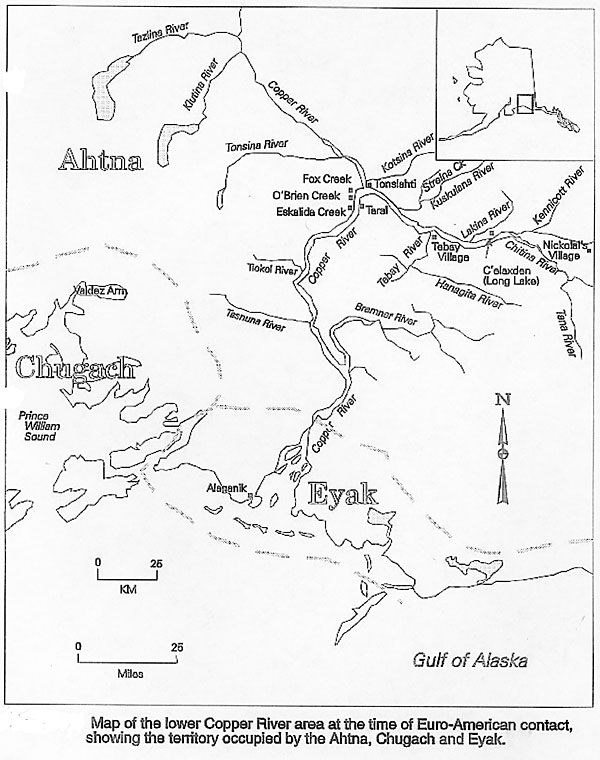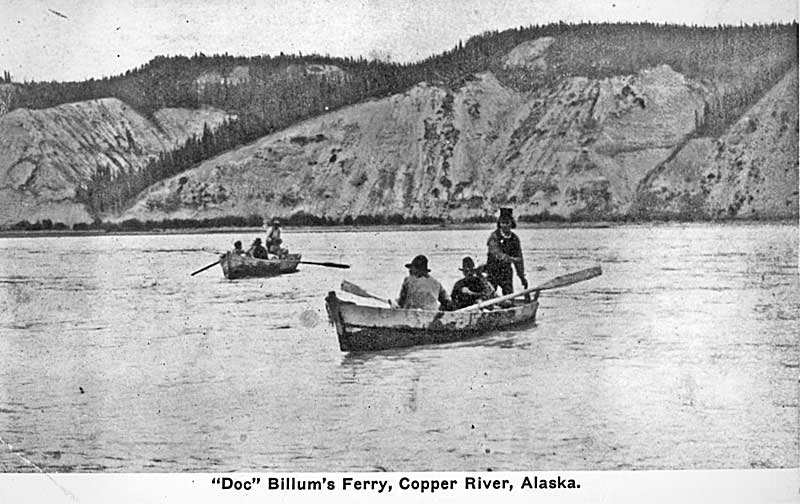Chapter 4, pt 1: The Russian C'eyigge'
t was always the tsedi--the copper. The legend of the tsedi was the legacy of the chief. Nicolai’s prospect lives with us today as a subtle, almost forgotten part of our heritage. The mythical outcropping was real, but it was not what the whites believed it to be. It was really only a hint that a mountain of rich copper existed. It was intertwined with the Russian incursions. The legend culminated in the building of the Copper River and Northwestern Railway--the ket’cheeten-eh’thloo-da-kee that invaded the very heart of our lower ‘Atna’tuuTs’itu territory, because the legend had become reality.The Russians came to Alaska not for the minerals, but for the pelts. The czarist empire made a fortune, probably financing entire wars on the proceeds taken from the Alaskan fur trade. Russia sold its monopoly of unhindered exploitation and government-protected trading that it held in its occupied part of the Alaskan territory to the Americans in 1867. In reality the monopolist Russian-American trading company, which was owned by friends and family of the czar and was protected by the Russian imperial navy, was really merely turning over its isolated coastal strongholds that had enabled the Russians to extract a rapidly diminishing amount of pelts from the Alaskan coastline and islands without any regard to the Native people who had lived there long before the Russian Empire or any European nations existed. The czar had little choice. American manifest destiny was alive and well. It would only have been a matter of time before the United States dominated the continent regardless. At least the Russians found a way that they could profit, selling their interests in a failing monopoly for an exorbitant price at a time when the U.S. navy could have taken it at almost no cost. At the time, the relationship between the Russian and American governments was amicable.
Twice our people drove the Russians from the valley. Lieutenant Allen asked Nicolai about these events, but the chief told him little except to say that the Russians, by their brutal actions, invited the retaliation. At Batzulnetas, which was on the Slana River, the Russians mistreated our women, and drove the men out of camp into the harsh winter weather without adequate clothing. The ruthless Czar Nicolas the First, who no doubt set the tone for such atrocious behavior, sent no military expeditions into our valley after 1848, though our people expected them to return one day to return. The legends of the massacres grew among our people until the dozen we killed had become three dozen and even more. It is the greatest of ironies that Nicolai was named after the very czar who held the Russian imperial throne when the Mendaesde massacred those twelve Russians at Batzulnetas.
Our chiefs--the ones who controlled Taral--were mindful that the Russians might someday return to avenge their dead. The elders had little doubt that another Russian military expedition would be bloody and final. We could not live in the same valley with the Russians. They were intolerable. Nicolai came into the world in 1867--the year Czar Alexander II transferred his Alaskan outposts to the United States. To the Americans, this was known as Seward’s Folly. It was a folly, all right. The deal ignored the reality that we had lived in the land long before there ever was an American nation.
Nicolai grew up in sight of the mountain ridge which is in the shadow of K’als’i Tl’aadi, “the one at cold waters.” Lieutenant Allen named it Mt. Blackburn. This ridge contained hints of the rich copper which first lured the Russians and later enticed the Americans into our ‘Atna’tuuTs’itu, forever changing our way of life.
Nicolai single-handedly created the role of supreme chief after taking the title of chief from his older brother Hanagita in the same year in which the Allen Expedition arrived. Hanagita was a reluctant chief at best. The duties of chief required Hanagita to remain at Taral to guard the most direct route into the ‘Atna’tuuTs’itu. Hanagita much preferred the solitary and relatively safe life of pursuing game up the Chitina and Nizina Rivers . It is said that when Nicolai challenged Hanagita, his older brother simply looked at him, puzzled that he would even want the role, handed him the traditional drum and spear, and walked away from Taral, vanishing into the mists of history somewhere into the valley which bears his name to this day.
Nicolai, backed up by his older brother Eskilida, immediately assumed his role, establishing his own aggressive brand of personal control over his people while taking over the unenviable role of guarding the main trading route leading to the Eyaks at Alaganik. Nicolai was the gatekeeper. The Copper River had long been the traditional access into the land of the Ahtna from the coast, although even that was beginning to change when trading vastly increased through a much easier route following the Tazlina River valley to the summit and crossing the coastal divide leading to the Knik trading post near the head of Cook Inlet.
Nicolai was forever mindful that the Russians might someday return. It would be up to him to deal with them first. Everyone knew this meant that the Russians would have to be killed before they overwhelmed Taral and the the other settlements of the lower and upper ‘Atna’tuuTs’itu’ country. It did not matter that the rights to occupy the Alaskan coastline had been sold. Nicolai needed to be personally convinced. Yet the fear of the Russians proved to be nothing more than apprehension of a vanquished spirit--a ghost that had quietly faded away. The Russian navy was long gone. With the birth of Nicolai, they could no longer protect their far-flung empire. The czar abandoned Alaska forever in favor of the American purchasers the same year Nicolai came into the world.
The spirit that quietly fades away is the common thread of this story. Nothing was ever conquered. We certainly were not. Even the land of the Uk’eledi--that of Mt. Wrangell, “the one with smoke on it,” was never vanquished. The land began restoring itself almost as soon as the railroad quit running. In the end, everything of significance simply died, sometimes without anyone being aware of the passing at the time. First it was the Russian presence, then the railroad, the mines, the towns, and finally the spirit that existed within the Kennicott Glacier that Cap sensed so strongly. It simply began to quietly shrivel away, as did the large, old mining camp which overlooked it--the place known to all as Kennecott.
From Nicolai’s camp of C’ena’ Tsedi near the Chitistone River, Nicolai would strike out toward the north, heading for the high hunting grounds in the ridges along the southern slopes of the Wrangells. The Wrangells derive their name from Baron Ferdinand von Wrangell, a red-haired Prussian governor of the Russian-American trading company back in the 1830s. The name remains as one of the most obvious examples of the subtle impact of the lengthy presence of the Russians. When they left Alaska, a part of the Russian spirit remained. A c’eyiige’ stayed behind to haunt us.
C’ena’ Tsedi, the winter home and birthplace of Nicolai, became Dan Creek. It was named by Stephen Birch, in honor of Dan Kain. He was one of the original eleven partners in the great Bonanza discovery and also an early partner of Stephen and Howard Birch in the hydraulic mine operation at Dan Creek which destroyed Nicolai’s old home. Hydraulic mining, like dredging, is one of the white man’s more destructive local forces. The creek proved rich with copper nuggets, though Stephen and his brother Howard were seeking placer gold. Tsedi were everywhere in the creek beds. The hydraulic miners removed the largest copper nugget ever found in the territory from Dan Creek.
To the north of C’ena’ Tsedi was the ridge which included the legendary, if largely forgotten, Nicolai Prospect. An early attempt to establish a working mine with the excavation of 300 feet of prospect tunnels convinced owners of the Chittyna Exploration Company that it was time to move on and abandon it. The outcropping was 4,250 feet in elevation and three and a half miles from the junction with the McCarthy Creek trail, which was only about seven miles from McCarthy.
The original showing consisted of spectacular colors of blues and greens said to be of breath-taking beauty. The prospectors who first saw it in 1899 must have thought they had found the elusive mother lode. Unfortunately, the vein quickly pinched out and did not warrant development, as they soon found out.
Nicolai Creek originated near the prospect. The small mountain stream flowed into McCarthy Creek. The men who discovered the famous Bonanza lode in 1900 also staked the claims which became the Mother Lode in 1906, located only a few miles upstream from the confluence of Nicolai and McCarthy Creeks.
For several years the Mother Lode remained little more than a prospect, as had the Nicolai before it. Once Kennecott acquired control, it became one of the three greatest copper mines in the district, sharing that distinction with the Bonanza and the Jumbo, and operating under the name Mother Lode Mines Coalition Company.
Probably largely because Nicolai’s name is permanently associated with the original prospect which bears his name, the most famous Ahtna figure of all time is Nicolai, a name forever linked to the copper and the tainted story associated with it.
 |
| Chief Nicolai and his wives, UAF Archives |
| This is the only confirmed photo which absolutely identifies the real Chief Nicolai |
If one were to believe the story as written by modern historians, it would be easy to conclude that Nicolai gave away the rich copper which resulted in the creation of the multi-million dollar corporation known as Kennecott for a winter cache of food. This makes our people appear to be the victims of the treachery of greedy white prospectors.
The story is far more complicated than that. The matter of the tsedi was not as historians made it appear. We gave away nothing.
When Lt. Henry Allen successfully ascended the Copper River by way of the nearly impassable Abercrombie Rapids in 1885, it was Nicolai whom he first sought. At the unusually youthful age of eighteen, Nicolai was already the Tyone--the supreme chief of all the ‘Atna’tuuTs’itu’ Valley.
Nicholai was not at Taral, as the lieutenant had anticipated. The Native people at the camp included Nicolai’s brother Skilly, an old woman and two children. A white prospector named John Bremner had been at Taral all winter. The gold-producing tributary downriver from Taral bears his name. That was one scraggly prospector who was not forgotten. Bremner strongly recommended that Lieutenant Allen to turn east into the upper reaches of the Chitina and Nizina Rivers to seek the tyone before proceeding any farther into the valley. Lieutenant Henry Allen’s party included Sgt. Cody Robertson, Pvt. Frederick W. Frickett, and a prospector named Peter Johnson who happened to be a partner of Bremner’s.



No comments:
Post a Comment